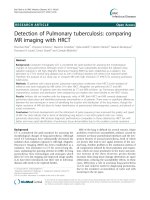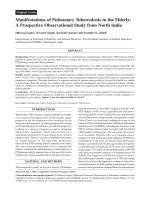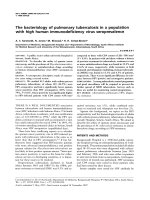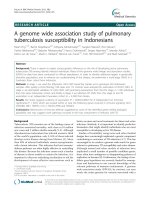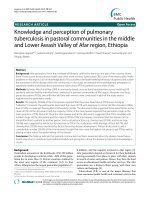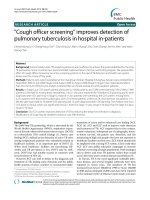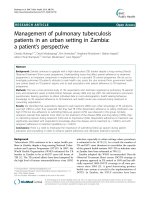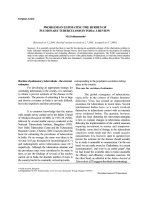PROBLEMS IN ESTIMATING THE BURDEN OF PULMONARY TUBERCULOSIS IN INDIA: A REVIEW pot
Bạn đang xem bản rút gọn của tài liệu. Xem và tải ngay bản đầy đủ của tài liệu tại đây (279.62 KB, 7 trang )
Ori
g
inal Article
PROBLEMS IN ESTIMATING THE BURDEN OF
PULMONARY TUBERCULOSIS IN INDIA: A REVIEW
M.S. Krishnamurthy*
(Received on 5.2.2001, Revised version received on 2.7.2001, Accepted on 9.7.2001)
Summary :It is generally agreed that there is need for developing an acceptable estimate of the tuberculosis problem in
India. Estimates obtained by the National Sample Survey have been found to be deficient for the purpose of enabling
rational allocation of resources and evaluating efficiency of anti-tuberculosis programmes. The WHO commissioned a
study on the subject and subsequently published a review of the global burden of tuberculosis, in which the Indian situation
was also considered. The Government of India also formulated a Committee in 2000 to address this problem. The author
reviews the estimates so far obtained.
Burden of pulmonary tuberculosis - the current corresponding to the population escalation taking
estimates place in the country.
For developing an appropriate strategy for
combating tuberculosis in the country, it is necessary
to obtain a precise estimate of the disease in the
community. The process of estimating it for as large
and diverse a country as India is not only difficult,
but is also expensive and time consuming.
It is common knowledge that the nation
wide sample survey carried out by the Indian Council
of Medical Research (ICMR) in 1955-58 (NSS),
followed by several similar surveys conducted at the
National Tuberculosis Institute, Bangalore (NTI),
New Delhi Tuberculosis Centre and the Tuberculosis
Research Centre, Chennai (TRC) had provided the
basis for estimating the prevalence of tuberculosis
in India. On an average, the same was taken to be
4.0 and 16.0 per thousand for bacteriological (C+)
and radiologically active tuberculosis cases (X+)
respectively. Although the tuberculosis situation and
the prevalence rates were considered to be static in
time, as per the findings of several of the studies
carried out in India, the absolute number of cases in
the country had to be constantly revised upwards,
The case for revision of estimates
The global resurgence of tuberculosis,
especially in the context of Human Immuno-
deficiency Virus, has created an unprecedented
awareness for tuberculosis in recent times. Several
international bodies have, as a result, involved
themselves in tuberculosis control with an intensity
never evidenced before. The question, however,
which has been disturbing the intervention-strategists
is how to evaluate changes in tuberculosis situation,
following the implementation of the control measures
requiring investment in money and manpower.
Evidently, some kind of change in the tuberculosis
situation could result and this would require
measurement. It is, however, open to question how
precise the estimate for the disease should actually
be to make it amenable to measurement. On the one
hand, we are made aware by Chakraborty, in a recent
communication
1
, and even in an earlier paper
2
, that
he had found the available data in India unsuitable
for efficacy and efficiency evaluation exercises. On
the other hand, an editorial in the Indian Journal of
Tuberculosis (IJT) suggests that ideals (in estimating)
* Health Scientist, Bangalore
Correspondence: Mr M S Krishnamurthy, 2315, 21st Cross, Banasanhai II Stage, Banglore 560 0070
The Indian Journal of Tuberculosis
194
M.S.KRISIINAMURTIIY
need not be pursued, as long as practicable estimates
were taken as ideals
3
. It is also understood from the
editorial published elsewhere in the same issue of
the IJT, that amidst this controversy, the Govt. of
India had arranged a 'consultation' at the NTI,
Bangalore for resolving some of the issues and
providing an estimate of the tuberculosis burden in
India
4
. It is presently intended to discuss some of
the problems here, in arriving at the estimate of the
tuberculosis burden in the country.
As has been brought out in an earlier para,
the rates of both bacteriological and radiologically
positive cases were more or less considered to be
unchanged in time so far. In the seventies, the NTI
had attempted to refine both the prevalence of
bacteriological and radiological cases
5, 6
. This, in the
first place, was in recognition of the limitation of the
yield of bacteriological cases by the investigation of
only two samples of sputum from the X-ray
abnormals in a survey. The limitation of X-ray
interpretation by two independent X-ray readers,
followed by an umpire reader, was also a factor to
consider in estimating the radiologically active
disease. Instead of investigating only two sputum
samples from X-ray abnormals, eight samples were
examined in a study by the NTI, in order to arrive at
an estimate of the total bacteriological case load in a
given community
5
. Further, in another study at the
NTI, instead of the conventional X-ray reading
technique, an innovative system of interpretation of
the radiographic abnormalities along with a series of
follow-up X-rays and other examination findings,
was relied upon in order to get a correct estimate of
the initially radiologically active cases in the
community
6
. This technique of X-ray reading was
termed as Joint Parallel Reading (JPR). From the
former study, it was found that the yield of
bacteriologically positive cases was more by 37% in
multiple sputum examination method ; and in the
latter study the JPR method of reading showed that
only 22% of the radiological cases, classified as active
cases by conventional method, could actually be
confirmed as truly active TB cases. Apart from the
JPR method, there is other amply corroborated
evidence to support the finding of an over-estimate
of radiologically active cases as obtained through the
method of conventional X-ray reading. In longitudinal
surveys carried out by the NTI, the prevalence of
these cases was 10.6 per 1000 in I survey & 6.8,
4.2 & 4.3 in II, III & IV surveys
7
. Further, in the
Chengalpattu study, while the observed high
prevalence of bacillary cases was at 10.68 per 1000,
the prevalence of radiological cases was 4 29 per
1000
8
. The New Delhi Tuberculosis Centre survey
also had shown substantial reduction of the X-ray
positive case prevalence in later years
9
, ostensibly
due to an improved interpretation of X-ray shadows,
probably influenced by the results from the NTI study
on the fate of X-ray cases diagnosed in a survey
(JPR study), available by then. It is strange that these
significant findings on the JPR study were not
incorporated by the NTI in estimating the burden of
disease, even to this day, till Chakraborty in his report
to the WHO used them to present a set of new
prevalence rates for the country
10,11
.
In the seventies, NTI had realised the need
to modify the expensive conventional survey
technique by adopting alternative cheap investigation
procedures. In this pursuit, NTI used 'symptom
elicitation' as the initial screening tool, instead of X-
rays
12
. In more recent times, Chakraborty et al found
that the estimates of prevalence of disease made by
the use of either of the screening tools should be the
same, if the symptom elicitation was made either by
a social investigator or by a senior experienced worker
in the field of tuberculosis
13
. These significant
findings influenced many of the tuberculosis workers
to carry out similar surveys in different areas of the
country, beyond the seventies. They carried out these
surveys in relatively larger population groups, from
which valid statistical estimates of prevalence of
disease could be computed. The findings of such
surveys, with and without applying the coirection
factor as suggested by Gothi et al
12
, and the findings
of two major X-ray surveys are given in Table 1.
The Indian Journal of Tuberculosis
ESTIMATING THE BURDEN OF PULMONARY TUBERCULOSIS IN INDIA
195
Table 1 : Prevalence of tuberculosis in India according to screening tools used
10
Survey
Period
of survey
Population
covered
Initial
screening
tool
Prevalence
of C+ cases
(11 respective
of smear result)
in 15+ age
group
Prevalence
after applying
correction
factor
Significance of
the result in
relation to NSS
at 95% confiden-
ce limits (for
corrected rate)
National Sample
Survey(NSS)
1955-58
2,00,429
X-ray
5.4
(5.05-5.69)
N.A.
Chengalpattu
(Tamil Nadu)
1968-71
2,04,624
X-ray
10.8
(10.36-11.26)
N.A
Wardha
(Maharashtra)
1982-88
4,57,136
Symp
2.4
3.6
P<0.05
Raichur
(Karnataka)
1988-89
40,496
Symp
8.8
(7.89-9.71)
13.2
(12.87-13.53)
P<0.05
Karhal Block
Morena District
(Madhya Pradesh)
1991-92
11.097
Symp
9.7
(7.87-11.52)
14.6
(13.89-15.21)
P<0.05
(Range for 95% confidence limits given in brackets) C+: culture/ smear positive cases Symp: Symptoms
It can be seen from Table 1 that the NSS
and Chengalpattu surveys were carried out using X-
rays as initial screening tool and for the rest of the
surveys, the initial tool of investigations was symptom
elicitation. For the surveys carried out using symptom
elicitation as initial screening, the respective rates of
prevalence of disease as observed and as computed
after applying the correction factor (as suggested
by Gothi et al
12
) have been furnished in col 5 & 6.
The observed prevalence rates, as well as those
obtained after applying the correction factors, were
found to be statistically different (P<0.5) from those
observed in NSS. In the light of significantly different
prevalence rates found in different surveys, beyond
the seventies, the assumption that the prevalence of
disease is uniform a l l through the country,
(“distributed ubiquitously” as suggested in Forum
under Editor replies
3
), may not be correct.
Unfortunately, and strangely at that, the same
hypothesis developed during the NSS, receives
support of the scientific community, even to this day
4
in the face of scientifically analysed data pointing
otherwise. Stranger still is the fact that the same
hypothesis is still being followed even by the NTI
for the purpose of monitoring the programme,
nationally. ARI studies currently being undertaken
by the NTI all over the country, are likely to throw
more light on this aspect, and would hopefully resolve
the issue.
Attempts at redefinition of the problem in recent
times
As has been brought out in an earlier
paragraph, that warning signals in respect of the
tuberculosis situation globally have been taken
seriously and there are now attempts to work out
the global burden of tuberculosis, including India.
Inspite of efforts to underplay the need and the
method used for revising the estimate for the
country
3,4
, there have been two attempts from the
WHO Geneva, to analyse the problem and arrive at
as precise an estimate as possible, in the Indian
context. Under the auspices of the WHO,
Chakraborty re-estimated the burden of disease in
The Indian Journal of Tuberculosis
M.S.KRISHNAMURTHY
196
the country, updating the technique followed
heretofore, by incorporating the findings of JPR and
multiple sputum investigation studies as explained
earlier
10
. This was followed by the work by
Christopher Dye et al in 1999, as a part of the global
exercise and expressed as a consensus statement by
the WHO Geneva
14
.
It was against this background, that the
Government of India convened an 'Expert
Committee' in 2000 and assigned them the task of
estimating the burden of TB in the country
4
. The
Committee reviewed all the available data, including
the estimates made by Chakraborty and Christopher
Dye. It identified the various surveys carried out in
the country which had followed similar investigation
procedures. The average both sexes all ages rates
from these surveys were standardised on the basis
of the observed prevalence rates in different age and
sex groups of each survey, with the projected
population structure of 2000. A weightage was
given for the size of the population covered in each
survey to estimate the burden of disease in the
country.
Table
2: Prevalence of tuberculosis cases in India (average rate/number) for standard population
Individual/
Group
PievalenceforC+/X+
cases
(per 1000)
No. of
C+/X+
(in , 000)
No. of
Sm+
Potential
(annual) of
case finding
under NTP
(No.)
Ratio of
Incidence:
Prevalence
Conventional
Prev of C+ cases @ 4.0 in 5+ age
3265
1632
1,305
1:3
estimate
Grou
p
Prev. of X+ cases
@
16.0 for 5+
13
,
060
age group (Sm+ cases 50% of C+)
Christopher
Prev of C+ cases® 5.05
4,851
2,182
1,745
1:27
D
y
eetal
14
Prev of X+ cases not estimated
)
(
44.9% of
C+
)
Chakraborty
Prev. of C+ cases @ 6.0
4,897
2,448
1,958
1:3
A.K.
10
Prev of X+ cases @ 3.0
2,448
-
Expert Group
Prev. C+ cases® 4.8
3,926
2,473
Govt. of India
(
63% of
(2000)
C+)
Chengalpattu
17
Prev. of C+ cases @ 8.75
5,881
3,071
2,352
Tamil Nadu
in 1 0+ a
g
e
g
rou
p
(@
52.23% of
(
estimates made
(
1968-70
)
I Surve
y
C+ cases of
based on
(
considered
p
o
p
ulation
that round
)
observed rates
below as 30%
)
in 1/3 of the
original sample
Prev of C+ cases @ 6.94
4,664
2,876
1,865
selected for
in 1 0+ a
g
e
g
rou
p
(@
6 1.67%
the BCG trial)
(1984-86) V I I Survey
of C+ cases)
Population considered: 960,178 ( in thousand) as per Christopher Dye et al
14
C + : Bactenologicallv positive cases (culture / culture and smear positive)
X+ : Rad iol ogically active patients
Sm+ : Smear positive cases
The Indian Jouinal of Tuheiculosis
ESTIMATING THE BURDEN OF PULMONARY TUBERCULOSIS IN INDIA
197
Based on the above exercise, one has now
access to a fresh set of estimates of the burden of
tuberculosis in the country, as of today. It serves to
provide one standard average prevalence rate,
corrected to represent the current Indian population
structure, age and sex-wise. This would eliminate
the confusion created by different rates put forward
by painstaking work by a number of individuals and
agencies. Table 2 provides information on the
estimates of prevalence obtained from various
sources, compared to that arrived at by the expert
group convened by the Government of India (2000).
Information is available in the Table on the estimate
of prevalence rates followed by the individual / groups
and the computed number of culture and smear
positive cases for a standard population.
Suitability of the newly computed estimate :
opening Pandora's box?
The estimates given in Table 2 and their
suitability for use require to be discussed here in some
detail. Since the conventional estimates, which were
so far followed by the NTI, had not taken cognizance
of the findings of its own studies in respect of
additional yield of 37% of the culture positive cases
by multiple sputum examination, and the likely fact
of a confirmation of only 22% of the radiological
cases arrived at by following the conventional method
of X-ray reading, the estimate of 32,65,000
bacteriological cases, could be an underestimate.
On the other hand, the number of 1,30,60,000 taken
as the burden of radiologically active cases is a gross
overestimate. To consider 4.0 and 16.0 per 1000 as
the prevalence of bacillary and X-ray active cases,
respectively, does not seem to be correct, on the
available evidence.
From Table 1, it can be seen that the
prevalence rate of bacillary cases is not uniform all
through the country. In support of this, it may be
stated that, even under NSS, pockets of high
prevalence like Calcutta slums were found.
Therefore, how far it is rational to consider an uniform
prevalence for the entire country, given its diverse
socio economic scenario and the sheer size, is
anybody's guess. Besides the differences by space,
there are changes in time as well, as seen from the
NTI and TRC studies in rural Karnataka and
Tamilnadu. NTI, from its own studies had found
that the proportion of smear positive to total number
of culture positive cases as observed in I, II, III &
IV surveys had changed from about 50% to just
about 15% in the span of some 22 years
15
.
Moreover, there was an observed change in the ARI
as well for the given area
16
. The TRC study in rural
areas of Tamilnadu has also shown a long-term and
sustained decline in the disease rates with time
17
.
However, no such change has been observed in the
urban population studied in New Delhi
9
. Thus, to
consider a uniform prevalence rate for average is
just an untenable hypothesis, both for space as well
as time for this country.
A look at the estimate arrived at by
Christopher Dye et al
14
suggests that they had taken
into cognisance the findings of most of the surveys
wherein X-ray was the initial screening tool. They
had chosen to ignore the findings of surveys, wherein
the initial screening was 'symptom elicitation'.
Disregarding the findings of these surveys had led
Dye et al to estimate of prevalence of bacteriological
cases @ 5.05/1000, which was possibly less
representative in the context of the whole country.
Further, the observed proportion between incidence
and prevalence cases in longitudinal study of the NTI
was 1:3 and this proportion was modified by Dye et
al as 1:2.7. The reason for this change requires an
explanation. Dye et al further chose to refrain from
estimating the prevalence of radiologically active case
load, the most likely and an understandable reason
for this being the lack of confirmation of such cases,
as brought out by JPR study of the NTI and also by
TRC studies, as explained above.
A look at the estimates of Chakraborty
10,11
the other hand, shows that he has refined the
estimates of bacillary as well as radiologically active
cases, based on earlier NTI studies on multiple
sputum examinations and JPR technique of X-ray
reading. It is true that when the estimate of
bacteriological cases is increased, with the
assumption of investigation of eight sputum samples,
there would be considerable decrease in radiological
cases, as most of these cases, could be represented
as bacteriologically positive cases, with any of the
eight sputum sample becoming positive. Thus, the
decrease may not appear illogical at all, and is no
The Indian Journal of Tuberculosis
M.S.KRISHNAMURTHY
198
doubt affected by the use of evaluated data from
field studies. However, it could be seen that he had
chosen not to consider the fact of changes occurring
in age, sex structure of the community. In all this,
he had followed the hypothesis of no change in
prevalence rates over time, calculating the absolute
numbers on the basis of current population size,
without taking into account the age-sex changes in
the population, affecting the prevalence rate. The
higher and lower prevalence rates, found in other
surveys are no doubt represented by him as ranges,
with an arbitrary midpoint giving the average.
The exercise made by the Expert Committee
convened by the Government of India (2000) is
unique indeed, attempting the standardisation of
observed prevalence in different age groups with the
projected population of 2000. Weightage was
accorded for each of the surveys, based on the
populations investigated in each survey for finally
arriving at an estimate of both C+ and X+ cases.
However, not considering the findings of surveys
wherein the initial investigation tool was 'symptom
elicitation' made the estimate less representative in
the country's context. Further, and more importantly
at that, failure to take cognizance of the findings from
NTI studies on multiple sputum examination and JPR
technique of X-ray reading, as done by Chakraborty,
is bound to lower the estimate of bacillary cases and
raise the estimate of radiological cases. These appear
to be serious flaws in the estimate.
Though the proportion of smear positive
cases out of the total bacteriologically positive cases
was found to vary from 44% to 58% in the first five
longtudinal surveys
7
(it was as low as 15.8% in 1984
survey
15
), by the NTI and about 48% in the TRC
study
17
, the expert committee's decision to consider
the proportion at 68% does not appear logical. This
unreasoned stance makes the estimate of smear
positive cases unreasonably high and unacceptable.
CONCLUSION
With the renewed concern for tuberculosis,
globally and in Ind ia, there is an augmented
intervention effort for tuberculosis control.
In view
of this, there is a perceived need for developing
an acceptable estimate of the problem, to enable
the programme planners to allocate resources,
as wel l as to evaluate the efficiency of
programme delivery.
The available estimate obtained
from the NSS has been found deficient for these
purposes. The WHO had commissioned a study of
the tuberculosis situation in India based on available
data, published under its technical reports series
10
.
They had followed this up with publication of a
review of the global burden of tuberculosis, in which
the Indian problem was also estimated
14
. Later still,
the Government of India had formulated an expert
committee in the year 2000, which had deliberated
on the issue and suggested a revised set of prevalence
rates for the country. In this paper the above estimates
have been reviewed.
The conventional rates of C+ and X+ disease
at 4.0 and 16.0 per thousand on the average were
not acceptable, since they had not tak en into
consideration the under-diagnosis due to the number
of sputum samples (two) customarily examined in
surveys, and the over-diagnosis due to the X-ray
reading technique. The revised rates as worked out
by Chakraborty in the Report commissioned by the
WHO, had made good this deficiency
10
. However,
he had not taken into consideration the fact of
demographic changes occurring due to age and sex
variations in the population with time. Both the reports
by Chakraborty as well as by Christopher Dye, as
brought out by the WHO, had not taken into
consideration the surveys carried out on the basis of
symptom elicitation in the population, and thus had
missed one of the essential features of the
epidemiological situation in India, as shown in Table
1, that is, the prevalence rates were different from
area to area and not similar, as was their hypothesis.
In giving an average prevalence rate for the country,
they could thus be on untenable grounds. However,
this deficiency may seem to be offset to an extent
by the ranges they had chosen to give for each of
the estimates
10,14
, thus admitting the fact of disparate
rates from area to area. Even then, it could be a
debatable exercise to present an average for such
rates, as were found to be lying outside the 95%
confidence limits, as in this case. It appears to be as
far fetched an exercise as presenting an average rate
of pulmonary tuberculosis, which would be globally
applicable. To the credit of Chakraborty, it can be
said that though he had presented an average rate
The Indian Journal of Tuberculosis
ESTIMATING THE BURDEN OF PULMONARY TUBERCULOSIS IN INDIA
199
for the country
10
, he also found it indefensible
1
. It
appears that he had compromised on the rates in
vogue, even as he found them inappropriate. Further,
the reason for the ratio of incidence : prevalence, as
shown to be 1:2.7 by Dye et al, is not justified on the
basis of available information
14
.
The rates, as worked out by the Government
of India expert group, suffer from the same lacuna
of not considering the results of surveys on the basis
of symptom elicitation and concluding on an equal
average prevalence rate for the entire country. The
latter had also erred in disregarding the overwhelming
evidence of under-diagnosis of bacteriological cases
in the surveys, related to the number of sputum
specimens examined, as well as on the over-diagnosis
inherent in the X-ray reading technique. Moreover,
they had chosen to consider the proportion of smear
positive cases to be over 60%, for which there is no
support from the available data. Thus, the
prevalence rates given above by different groups
were different from each other, and each with
obvious lacunae in estimating procedures. To
be meaningful, these differences need to be
resolved, as they are bound to influence the
decision of health planners for allocation of funds
and for monitoring of the programme.
REFERENCES
1. Cliakrahorty AK, Epidemiology of TB ; Some ifs and buts,
IndJ Tub, 2000,47, 184
2. Chakraborty AK, TB situation in India: measuring it through
time, IndJ. Tub,
1993,40,215
3. Editorial, On estimation of burden of TB in India,
Ind J.
Tub,
2000, 47, 127.
4. Editor replies,
Ind J. Tub,
2000, 47, 186
5. Nair SS et al, Precision of estimates of prevalence of
bacteriologically confirmed pulmonary TB in general
population,/m/./. Tub, 1976, 23, 152.
6. Gothi GD et al, Interpretation of photofluorograms of active
pulmonary TB patients found in epidemiological survey
and their five year fate, Ind J Tub, 1974, 21, 90.
7. NTI, Bangalore, TB in a rural population of south India : a
five year epidemiological survey, Bull.Wld Hlth Org, 1974,
51, 473.
8. TB Prevention Trial, Madras, Trial of BCG vaccines in
south India for TB prevention, Ind J Meet Res., 1980, 72
(suppl), 1.
9. New Delhi TB Centre, Study of epidemiology of TB in an
urban population of Delhi ; Report on 30 year follow up,
IndJ. Tub, 1999,46, 113.
10. Chakraborty AK, Prevalence and incidence of tuberculosis
infection and disease in India, WHO Technical Reports Series,
WHO/TB/97/231
11. Chakraborty AK, Global epidemiology of TB in TB
Research into the 21
st
century, 1998, Pp I -190, Tuberculosis
Research Centre, Chennai.
12. Gothi et al, Estimation of prcv. of bacillary TB on the basis
of Chest X-ray and / or symptom screening, Ind J Med
Res, 1976,64, 1150.
13. Chakraborty AK et al, Prevalence of pulmonary TB in a
peri-urban community of Bangalore under various methods
of population screening, IndJ. Tub, 1994, 41, 17.
14. Dye, Christopher et al, Global burden of TB; estimated
incidence, prevalence and mortality by country, JAMA,
Aug 18, 1999,282,677.
15. Chakraborty et al, Prevalence of TB in a rural population
of south India by an alternative survey method without
prior X-ray screening of population, Tubercle and Lung
Dis, 1995,76,20.
16. Chakraborty et al, Tuberculosis situation in a rural
population of south India ; 23 year trend, Tubercle and
Lung Dis, 1992, 73,213
17. Tuberculosis Research Centre, Chennai, Trends in
prevalence and incidence of tuberculosis in south India, Int
J Tuber Lung Dis, 2001, 5(2), 142
The Indian Journal of Tuberculosis

